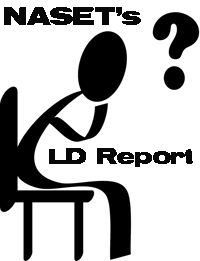LD Report
Go to the PDP Menu
NASET LD Report
Welcome to The NASETLD Report, NASET 's e-publication on the latest information on learning disabilities. Individuals with learning disabilities represent approximately 50% of all students receiving special education services. Therefore, it is inevitable that special education professionals will be working with students with LD throughout their entire careers. The NASETLD Report is a monthly education resource that provides NASET members with a comprehensive overview of learning disabilities. The NASETLD Report will cover many areas of study in the field of LD. It will focus on the research, writing, and practical information that we have obtained on causes, characteristics, eligibility, assessment, and teaching strategies.

Go to the PDP Menu
Latest Issue:
The Fundamental Role of the Native Language in Teaching English to Children with Dyslexia
Archived Issues:
Introduction to Learning Disabilities
Theoretical Perspectives on the Causes of Learning Disabilities
Characteristics of Children with Learning Disabilities
Eligibility Determination for Specific Learning Disabilities
The Importance of Response to Intervention (RTI) in the Understanding, Assessment, Diagnosis, and Teaching of Students with Learning Disabilities
Effective Teaching Strategies for Students with LD
Promoting Positive Social Interactions in an Inclusion Setting for Students with Learning Disabilities
Transition Services for Students with Learning Disabilities
IEP Development and Educational Placement Options for Students with Learning Disabilities
Assessment Measure Used to Determine Learning Disabilities in Students
Differentiation: Strategies and Educational Impact
Learning Disability Identification: What You Need to Know about the Discrepancy and Patterns of Strengths and Weaknesses ("Third Method") Model
What is a Learning Disability, Really?
Social Skills and Academic Achievement
Accommodations and Modifications: Wait They're Not the Same?
Using Universal Design for Learning: Successful Transition Models for Educators Working with Youth with Learning Disabilities
Students with Learning Disabilities Participating in Reccess
Dyslexia: An Upside Down World in a Right Side Up World
Adolescent Literacy
The State of Learning Disabilities Facts, Trends and Emerging Issues
A Discussion of Reading Disorders: Perceptual, Cognitive and Mnemonic Elements
Learning Disabilities Today: An Examination of Effective and Not-So-Effective Interventions
Test Anxiety and Students with Learning Disabilites
Limitations on Response to Intervention with Emphasis on General Education Teachers
Benefits and Limitations of Technology Use for Students with Reading and Writing Disorders in the General Education Classroom: A Systematic Review
General and Special Education Teachers’ Perceptions of the Implementation of Differentiated Instruction in Elementary Classrooms with Learning Disabilities Student
Strategies for Supporting Students Struggling with Sight Word Retention
A Critique of: Cognitive Risk Factors for Specific Learning Disorder: Processing Speed, Temporal Processing, and Working Memory
Diverse Learners and Intervention: A Review of Literature
Improving Reading Skills in Students Below Grade Level: A Literature Review
New Strategies for Students with Learning Disabilities
NCES Releases Latest NAEP Long-Term Trend Report for Ages 9 and 13
The Practices of Teachers in the Development of Post-Secondary Skills in Students with Learning Disabilities
They Sing Their Way to Reading
Supporting the Mental Health of Students with Dyslexia: What Educators Can Do?
Evidence Based Practice Research: Elkonin Boxes
Overcoming Dyslexia: Music, Rhythm, and Prosody
Students Coping with Dyslexia in General Education Classrooms